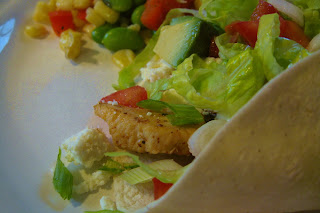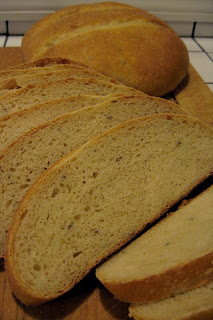Although I cook a lot there are certain recipes which I have never tried for one reason or another. Until a couple of weeks ago, one of these was a soufflé. It seemed to be too difficult; fussy, with a lot of prep and, when we entertain, I like to have dessert made and ready to go (except for garnishing) after the meal. Whipping up a soufflé and baking it seemed as though it would be too time-consuming.
I have been corrected. :)
I found this recipe in a February 2007 issue of Cuisine at Home magazine, and it really called out to me. Lemon cheesecake soufflé. I adore cheesecake, and lemon is such a lovely springtime flavor, plus the accompanying raspberry sauce would go with it so well. I just had to try it.
Now, the original recipe was for 8 servings and I was only going to make two. Because if I made 8 (6, 4…), we would eat them all. I wasn’t certain if soufflés would take to being leftover well, so I would only make what we should eat.
Of course, scaling the recipe down so much left me with needing to use ¾ of an egg yolk, and 1-1/4 egg whites. I considered doing just that, extra preparation steps with beating the yolk or white, and measuring them, but decided against it. Life is too short. I used a whole yolk, and one white. And it worked just fine.
I first made the raspberry sauce and set it aside. The original soufflé recipe called for buttering the ramekins and sprinkling with crumbs, then baking the “crust”. I skipped this step, preferring to spray the ramekins with cooking spray and not using the crumbs at all. I also made a small change in how the lemon mixture was prepared, but that was minor and was only to make that particular step a little easier. I also used fat free “Super Skim” milk and neufatchel cheese.
As an experiment I prepared the batter a few hours in advance, filled the ramekins, and kept them in the refrigerator until I preheated the oven (I used a toaster oven for the 2 ramekins), at which time I placed them on the counter to start to come to room temperature. Then they were baked. They rose very nicely, about 1” above the rims of the ramekins. But be warned, they are to be served immediately. Get some powdered sugar in a small strainer or sifter, have small plates at the ready for placing the soufflés on after they are removed from the oven, and have the sauce already on the table for everyone to use.
Mine fell after about a minute, so take those babies out of the oven, plate, dust with powdered sugar, and serve.
I understand that you can refrigerate any leftovers and that although they taste great, they will not be “pretty”.
All told, this really was a super-easy recipe, and yielded great results. The soufflés tasted lemony and very cheesecake-like, and were nice and light in texture. The raspberry sauce is a perfect accompaniment, and I added a little Chambord-cornstarch mixture (2 tablespoons of the black raspberry liquer to ¾ teaspoon cornstarch) to punch up the berry flavor and thicken the sauce as well.
Excellent choice for a spring or summer dinner party, and now I know that they can be prepped ahead I will definitely make them again.
* Exported from MasterCook *
Lemon Cheesecake Soufflés with Crushed Raspberry Sauce
Recipe By: Cuisine At Home, Issue 63
Servings: 4
Amount Measure Ingredient -- Preparation Method
-------- ------------ --------------------------------
1/2 cup 2% low-fat milk (I used Super Skim fat-free)
1/4 cup sugar
2 ounces cream cheese -- cubed, softened (I used neufatchel)
1/4 cup fresh lemon juice -- strained
1/8 cup all-purpose flour
1/2 tablespoon fresh lemon zest -- minced
1 1/2 large egg yolks -- room temperature
1/8 teaspoon vanilla extract
2 large egg whites -- room temperature
1/4 teaspoon kosher salt
1/8 teaspoon cream of tartar
2 tablespoons sugar
6 ounces raspberries -- frozen
1/4 cup sugar
1/2 teaspoon fresh lemon juice
pinch salt
Preheat oven to 400F
Coat 4 6-ounce soufflé cups with cooking spray, and then set aside.
Combine egg yolks and vanilla, in a small cup and set aside. Simmer milk, sugar, and cream cheese over low heat until cream cheese melts. Add the lemon juice and zest and flour and whisk until smooth. Turn up the heat to medium-high and whisk constantly until thick and bubbly, about 4 minutes
Whisk the egg yolk mixture into the lemon mixture and cook for 2 minutes. Transfer pan to a bowl filled with ice water to cool.
Beat egg whites with salt and cream of tartar to soft peaks in a bowl with an electric mixer on high speed.
Gradually add 2 tablespoons sugar, beating until stiff peaks form. Blend 1/4 cup of the whites into the lemon mixture with a whisk, and then fold in the remaining whites until there are no white streaks.
Fill the ramekins 1/2" from the top with the batter and bake on a baking sheet until puffed, 18-20 minutes. Test for doneness by inserting a skewer into the center-- the soufflés are done when the skewer comes out clean or just slightly moist.
Dust with powdered sugar, serve immediately with warm raspberry sauce.
RASPBERRY SAUCE: Simmer all ingredients in a saucepan for 5 minutes, then crush with a potato masher.
Source:
"CAH Issue 63"
- - - - - - - - - - - - - - - - - - -
Per serving as made in the original recipe:
255 Calories (kcal); 8g Total Fat (4g Saturated); (26% calories from fat); 6g Protein; 42g Carbohydrate; 98mg Cholesterol; 222mg Sodium
Food Exchanges: 0 Grain(Starch); 1/2 Lean Meat; 0 Vegetable; 1/2 Fruit; 1 1/2 Fat; 2 Other Carbohydrates
Using skim milk and neufatchel cheese:
Per serving: 242 Calories (kcal); 6g Total Fat (3g Saturated); (21% calories from fat); 6g Protein; 43g Carbohydrate; 93mg Cholesterol; 237mg Sodium
Food Exchanges: 0 Grain(Starch); 1/2 Lean Meat; 0 Vegetable; 1/2 Fruit; 1 Fat; 2 Other Carbohydrates













